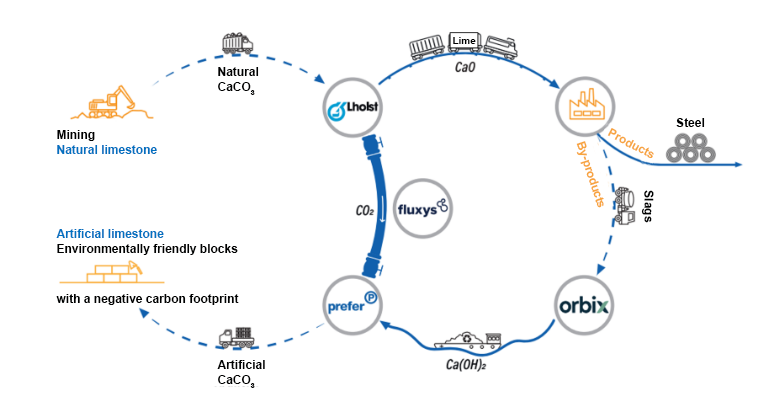Fluxys helping to decarbonise industry in Wallonia
Fluxys' strategy is on the move. The latest example of that is a project in Wallonia in which our company is set to play a pivotal role. This time, it's all about the circular economy, and how CO2 from an industrial plant in the Liège region could be used to make concrete blocks for use in local construction.
The block that eats CO2
Fluxys, Lhoist, Orbix and Prefer have launched a feasibility study for an innovative project called CO2ncrEAT – a concrete block that 'eats' CO2. As its name suggests, the goal of the project is to manufacture building blocks from CO2 and so help to decarbonise Walloon industry.
How does it work?
It's all explained in the diagram below. Located close to each other in the Liège region are three manufacturers: Lhoist, a lime producer, Orbix, which processes slag (a by-product of steel production), and Prefer, which manufactures prefabricated products used in construction.

The idea is that Prefer will use raw materials from Orbix and CO2 from Lhoist to manufacture sustainable building blocks. Since the blocks will contain more CO2 than is needed to produce them, they will have a negative carbon footprint. This is where Fluxys comes in: with our expertise in pipeline transmission, we will make the project possible by moving the CO2 from Lhoist's site to that of Prefer, a distance of just under 2 km. Around 20,000 tonnes of CO2 could be transported and recovered this way each year.
Our infrastructure driving industrial synergies
This project shows that capturing, transporting and reusing CO2 is an effective way to move towards the goal of carbon neutrality by 2030.
"Our CO2 transmission infrastructure is allowing us to forge industrial synergies and create local value added, while also decarbonising industry. We are turning waste into a resource, and that resource will create value locally. What's more, this innovative project opens up a raft of possibilities. It is a circular model that could easily be replicated elsewhere: all that's needed is a source of CO2, a source of slag, and a local market for concrete blocks," says Vincent Flon, Innovation Projects Developer.
The feasibility study should be complete by the end of this year. The project partners hope to secure EU innovation funding. Subject to a final investment decision, the project could be up and running by 2024.